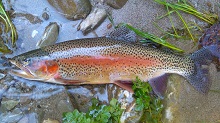Small Freshwater Shrimp Health of Food Chain
Canadian Angling.com: Scientists are now using biological markers to determine the presence of toxic substance in the river and lakes. They are using the European method of using the small freshwater shrimp (Gammarus) as their biological marker. They can see the impact the contamination has on the shrimp’s biological functions and use this as a method of measuring the contamination.
Many people do not realize that 90% of the life on this planet is made of invertebrates and they can act as an early warning system and are a key part of the food chain. France (Cemagref researchers) is leading in the research and using this to monitor their rivers and lakes. One technique that is used by the Cemagref researchers is based on determining the effects these chemicals have on the tissue and cells of animals and the Gammarus shrimp is the perfect species to observe and measure. This is because the shrimp is very abundant and very easy to catch using a net. The shrimp feeds exclusively on the remains of plant and animal matter. This makes it easy to compare to laboratory kept specimens to measure the effects these toxins have.
We release many kinds of pollution into the rivers, including insecticides, pesticides and endocrine disruptors and the Cemagref researchers can measure the effects of these on the metabolism of the shrimps cells and tissues, even at low concentrations. Some chemicals are neutoxic (effect nervous system), endocrine disruptors (effect hormonal system) and some are classified as genotoxic (effect the DNA). The researchers are tying to develop markers for each type of contaminant. They have so far developed a marker for acetylcholinesterase, an enzyme involved in neurotransmission, vitellogenin which is a endocrine marker, and the comet test measures the percentage of damage to the DNA some chemicals cause. Studies are now being expanded to other species of Gammarus in order to monitor water quality. Émilie Lacaze (Cemagref labs in Lyon) actually uses Gammarus spermatozoids because they are more sensitive to the contaminants. She has focused her research into the developmental problems these chemicals have on the spermatozoids and has found damage as high as 20%. It is important to note that these chemicals attack three different areas of the shrimp, but the end result is the same, the overall populations are threatened. While many people may now worry about the effects these chemicals have on the tiny shrimp, they must remember that these are the basis of our food chain and will affect the next species up, the trout which eat high amounts of the tiny shrimp.



